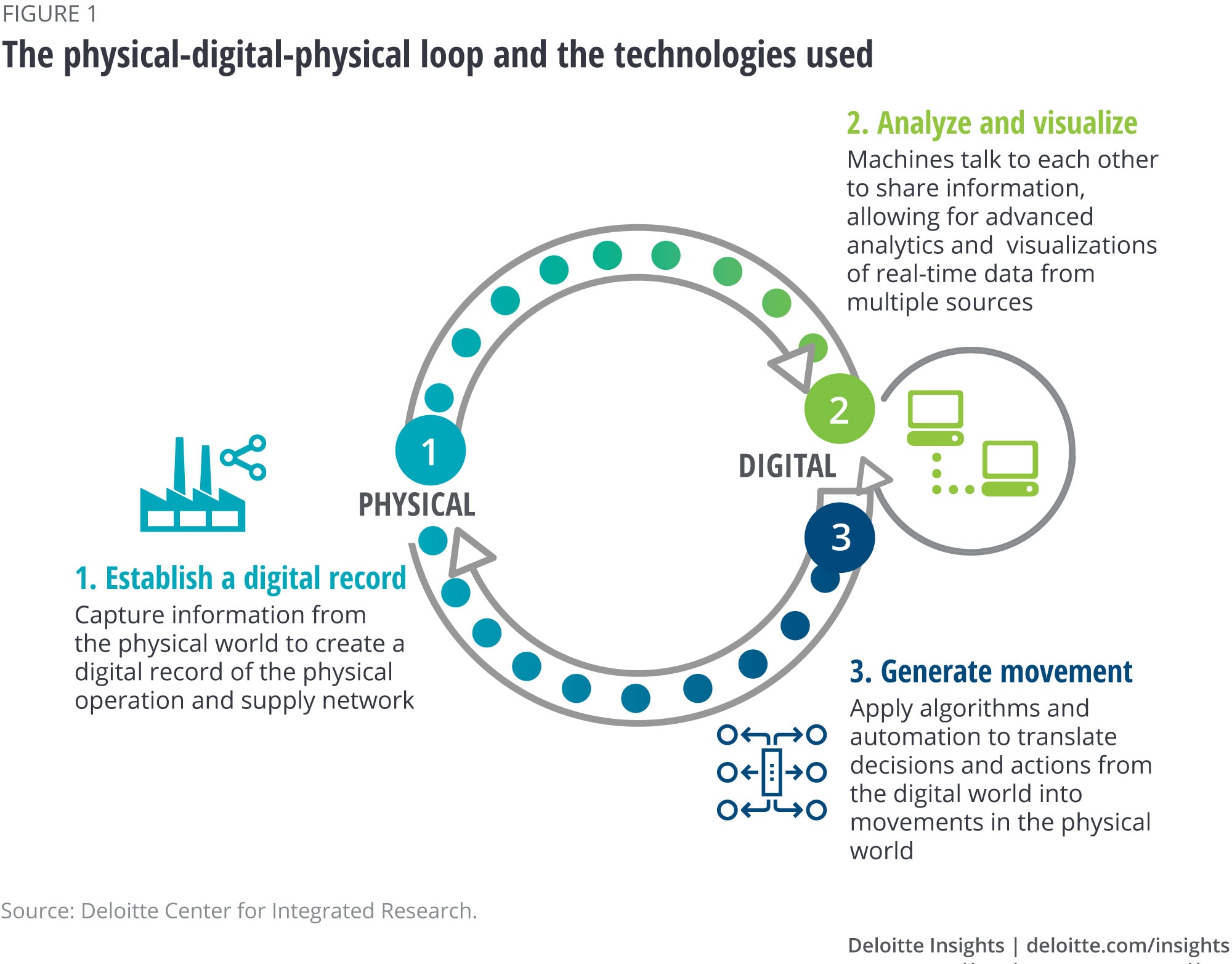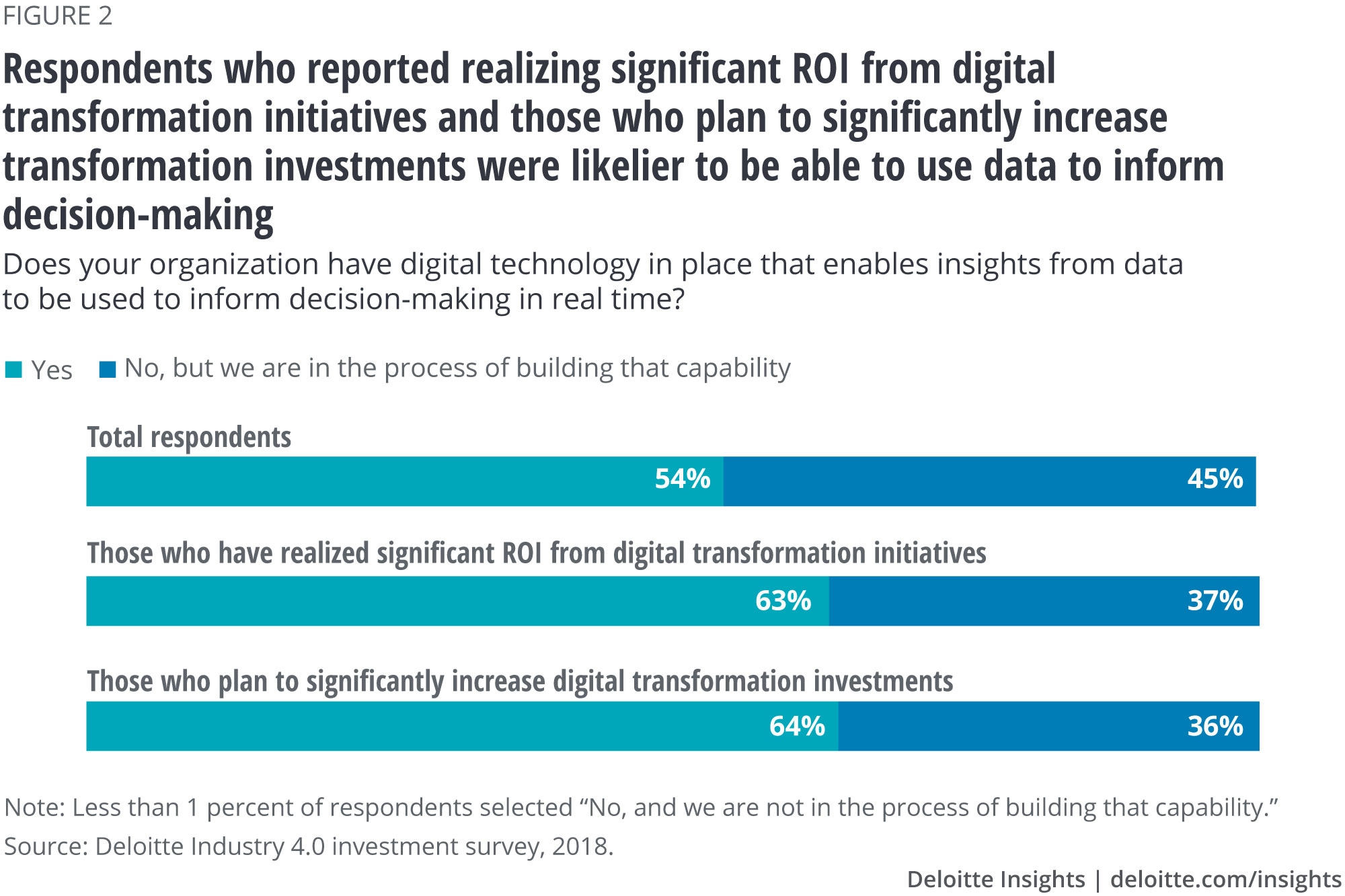
Around the physical-digital-physical loop A look at current Industry 4.0 capabilities
11 October 2018
A crucial part of Industry 4.0 is the continuous loop of information and action between the physical and digital worlds. Many organizations may struggle to complete this loop—especially the last, most important stage.
Around the physical-digital-physical loop: A look at current Industry 4.0 capabilities
When business leaders talk about digital transformation, they often use the term “Industry 4.0” in the same breath. In fact, it can be argued that these two concepts go hand in hand. Deloitte has described Industry 4.0 as the integration of digital information from many different sources and locations to drive the physical act of doing business, in an ongoing cycle. Throughout this cycle, real-time access to data is driven by the continuous and cyclical flow of information and action between the physical and digital worlds. This flow occurs through an iterative series of three steps, collectively known as the physical-digital-physical (PDP) loop1 (figure 1).

Learn More
Explore the Industry 4.0 Paradox report:
View the entire Industry 4.0 collection
Subscribe to receive updates on Industry 4.0
In the first stage, physical-to-digital, information is captured from the physical world to create a digital record. That data is then analyzed in the digital-to-digital stage to draw meaningful insights. In the final stage, digital-to-physical, those insights spur action and change in the physical world. The result is a more flexible system capable of adapting to and learning from changes in the environment.
Our digital transformation survey reveals both insights into what drives organizations to seek digital transformation as well as a deeper story about how they are navigating this loop: the actual creation, use of, and—most importantly—ability to act upon data derived from connected technologies. This ability to fully harness each stage of the physical-digital-physical loop is crucial to the full realization of Industry 4.0—and many organizations may not yet be able to execute this fully in practice.
The ability to fully harness each stage of the physical-digital-physical loop is crucial to the full realization of Industry 4.0. Many organizations may not yet be able to execute this fully in practice.
Traveling the loop—but not always finishing the journey
While most respondents have the first stage of the PDP loop in place, and many have the second, far fewer are yet able to harness the last, most important stage—the ability to act on the data they have analyzed.
While most respondents have the first stage of the PDP loop in place, and many have the second, far fewer are yet able to harness the last, most important stage—the ability to act on the data they have analyzed.
Physical-to-digital. More than 90 percent of respondents report gathering at least some data from the physical world via enterprise resource planning (ERP), customer relationship management (CRM), or product lifecycle management (PLM) systems, or nontransactional internal systems such as email. More than half of respondents also report collecting data from some form of Internet of Things (IoT), whether field-based (57 percent) or facility-based (58 percent), while 51 percent utilize predictive model outputs.

Digital-to-digital. When it comes to being able to analyze and extract value from the data—the digital-to-digital stage—confidence among respondents abounds. Those who have access to data report feeling fairly confident in how well they are able to use it. Seventy percent believe they use nontransactional systems extremely effectively. At the same time, however, just 50 percent believe they use ERP and PLM systems extremely effectively—a noteworthy drop from the 91 percent who use these tools.
However, as capabilities grow more advanced and expand to include connected assets, confidence declines: 41 percent report using facility-based IoT extremely effectively, while 40 percent say the same for field-based IoT, and 39 percent for predictive models. Respondents who rated their effectiveness in using the data “somewhat effectively” were at 41 percent, 39 percent, and 38 percent, respectively, for these three capabilities—suggesting that many executives are still gaining familiarity with and ability to effectively use data from connected systems.
Digital-to-physical. Making that last leap back into the physical world is perhaps the most important step, and the one that truly classifies a process as “Industry 4.0.” In this regard, slightly more than half of respondents—54 percent—rated themselves as capable of using data to make decisions in real time, while 45 percent said that they don’t currently have that capability but are building it. This suggests that many organizations recognize that this capability is important, and harbor an active desire to be able to fulfill that last mile of the Industry 4.0 journey.
Making that last leap back into the physical world is perhaps the most important step, and the one that truly classifies a process as “Industry 4.0.” In this regard, slightly more than half of respondents—54 percent—rated themselves as capable.
Interestingly, respondents who reported significant ROI from digital transformation initiatives, as well as those who noted that they plan to significantly increase their investments in digital transformation, were likelier to note that they are already capable of using data to make decisions, suggesting that those who invest in digital transformation can benefit from more informed decision-making (figure 2).
This suggests that, as companies become more involved in digital transformation and build their capabilities, they are likelier to realize its benefits—and keep investing to further grow their expertise.
As companies become more involved in digital transformation and build their capabilities, they are likelier to realize its benefits—and keep investing to further grow their expertise.

Getting around the loop
The impact of digitally transformative technologies on organizations will likely only continue to grow. These connected technologies make it possible for organizations to access data to drive action throughout their business. To do so, however, they should first be able to not only create information, but be able to derive insights from it—and act on those insights.
To fully leverage Industry 4.0, organizations can:
- Focus on completing the PDP loop as a roadmap for technology investments—particularly that last, most important step of being able to act upon the data generated by connected systems. The result can be a more flexible, adaptive organization. To be sure, the ability to generate and analyze data is highly valuable, but organizations should explore and invest in technologies, talent, and capabilities that can enable them to use it to drive their businesses forward.
- Recognize that investment begets Industry 4.0 success, and increases the risk that those who haven’t gotten started could be left behind. Executives who report seeing significant ROI on their digital transformation investments are much likelier to report the ability to act on information and complete the PDP loop. Those who plan to significantly increase their investments responded similarly, suggesting that success begets success. But what this also means is that the gap between those organizations that have gotten started and those that are waiting to do so will likely only widen in the future, as those who see success continue to build upon it.
- Consider the talent you’ll need—both to drive the loop and understand how to leverage the information it generates. Leading talent will be needed, not only to implement Industry 4.0 technologies but also to produce data and drive responsive action.
- At the same time, realize you may already have more tools than you think. More than half of respondents already have tools at their disposal: IoT data collation, ERP systems, social media listening, and predictive modeling. Organizations may want to first build on their existing capabilities, enabling them to identify and make more targeted investments in what they actually need.
It can be difficult to keep pace with the changes brought about by the emergence of Industry 4.0. But by understanding and leveraging the PDP loop as a guidepost, leaders can better understand how to use connected technologies to drive value for their organizations.





